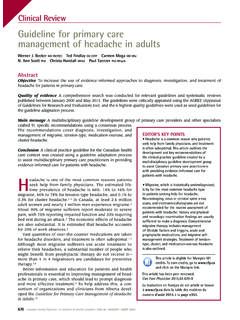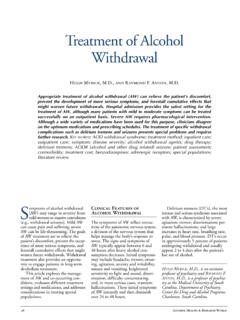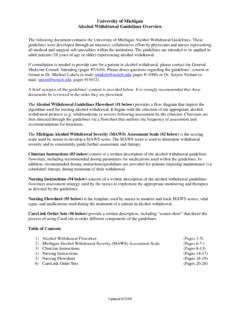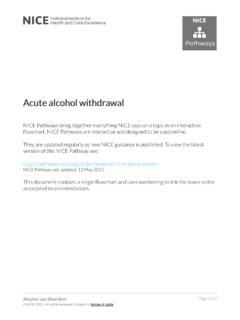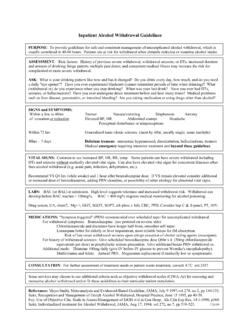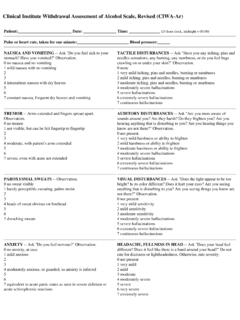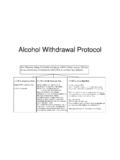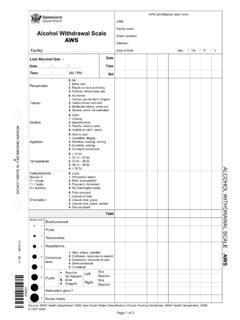Transcription of Clinical Institute Withdrawal Assessment for Alcohol ...
1 Case Report Clinical Institute Withdrawal Assessment for Alcohol Revised might be an unreliable tool in the management of Alcohol Withdrawal Erin Knight MD CCFP ISAM Leslie Lappalainen MD CCFP DipABAM. T he Clinical Institute Withdrawal Assessment for Alcohol Revised (CIWA-Ar) protocol (Figure 1)1 is the most common method of treating Alcohol Withdrawal in our institution and it is frequently used by family physicians. Although various rating scales for Alcohol Withdrawal have been described, the CIWA-Ar protocol managing Withdrawal with benzodiaze- pines is well Symptom-triggered benzodiazepine dosing has been demonstrated to lead to shorter duration of treatment and lower medication use compared with fxed-schedule Although the CIWA-Ar protocol was vali- dated in medically cleared patients in an Alcohol detoxifcation setting, it has also been evaluated in hospital ,6-8. However, the application of the CIWA-Ar needs to be carefully considered, and inappropriate use of the protocol has been This article describes a case in which an objective Alcohol Withdrawal scale (OAWS) was more useful for treatment, as the CIWA-Ar could not be applied.
2 EDITOR'S KEY POINTS Case Because accurate application of the Clinical Institute A 57-year-old Polish man presented to an urban hospital Withdrawal Assessment for Alcohol Revised requires at 12:18 PM after falling while intoxicated. His Glasgow taking a detailed medical history, it should not be used Coma Scale score was 11 and his serum ethanol level when a substantial language barrier exists, or when was 75 mmol/L at 3:53 PM. An eyebrow laceration was patients cannot provide a reliable history because of sutured, and a computed tomography scan of his head delirium, dementia, psychosis, etc. showed a trace subarachnoid hemorrhage. After review by the neurosurgery department, the patient was kept for An objective Alcohol Withdrawal scale can be tailored to observation and began to exhibit signs of Alcohol with- comorbidities and severity of Withdrawal , but it has not drawal. A CIWA-Ar protocol using lorazepam was initiated been validated as an alternative to the Clinical Institute at 8:50 PM with an initial score of 13.
3 Upon reassessment Withdrawal Assessment for Alcohol Revised protocol. It is at 7:41 AM, the patient had received a total of 10 mg of oral intended as an approach to treatment that can be useful when validated protocols cannot reliably be applied. lorazepam and a consultation with the internal medicine department was initiated. The patient's Withdrawal contin- ued to worsen, and lorazepam was switched to diazepam. POINTS DE REP RE DU R DACTEUR When seen in the internal medicine department at 3:45 PM, tant donn que l'application exacte de l' chelle des a regular 10-mg dose of oral diazepam 3 times a day was sympt mes de sevrage de l'alcool ( Clinical Institute added, and a consultation with the Addiction Medicine Withdrawal Assessment for Alcohol Revised ou CIWA-AR) Consult Team (AMCT) was requested. exige une anamn se d taill e, cette chelle ne devrait pas The patient was seen by the AMCT at 6:00 PM , tre utilis e s'il existe des barri res de langue importantes 30 hours into the Withdrawal process and 21 hours since ou lorsque les patients ne peuvent pas expliquer leurs starting the CIWA-Ar protocol.
4 The patient had received ant c dents m dicaux de mani re fiable cause d'un delirium, d'une d mence, d'une psychose et ainsi de suite. a total of 18 mg of oral lorazepam, 40 mg of intravenous diazepam, and 20 mg of oral diazepam, and he continued Une chelle objective des sympt mes de sevrage de to exhibit signs of severe Alcohol Withdrawal including l'alcool peut tre adapt e aux comorbidit s et la gravit agitation, diaphoresis, hypertension, tachycardia, and des sympt mes, mais elle n'a pas t valid e comme tremor. He was unable to converse in English, although solution de rechange au protocole CIWA-AR. Elle a pour he was able to speak Polish when a telephone translation but de servir d'approche th rapeutique susceptible d' tre service was briefy available. He was confused and disori- utile lorsque les protocoles valid s ne peuvent pas tre ented to time and place. There was minimal collateral his- appliqu s de mani re fiable.
5 Tory, with no previous admissions, no pharmacy records, no next of kin available, and a retired family physician This article has been peer reviewed. on record. He had signs of chronic liver disease including Cet article a fait l'objet d'une r vision par des pairs. clubbing, palmar erythema, and a palpable liver. Given Can Fam Physician 2017;63:691, 693-5 the patient's inability to converse, the AMCT discontinued the CIWA-Ar protocol and constructed an OAWS (Box 1). VOL 63: SEPTEMBER SEPTEMBRE 2017 | Canadian Family Physician Le M decin de famille canadien 691. Case Report Because of the apparent liver disease, diazepam was changed to 1 mg of oral lorazepam (which does not require hepatic oxidation) 4 times a day, with lorazepam as needed based on the OAWS. The patient's Withdrawal improved and his lorazepam requirements gradually declined. On day 4, scheduled lorazepam was decreased to 3. times a day, then to twice a day on day 5.
6 The patient remained hyperten- sive and received sporadic as-needed doses because of this. On day 6, the OAWS and treatment with lorazepam was discontinued and the patient was discharged in stable condition on day 8. Recommendations were pro- vided to the patient's Polish-speaking family physician regarding relapse prevention medications, with acamprosate being the drug of choice given his liver dysfunction. Discussion An important limitation of the CIWA-Ar is its heavily subjective nature. Only 3 of 10 components (tremor, paroxysmal sweats, agitation) can be rated by observation alone. The other 7 components require at least some discus- sion with the patient. Given that benzodiazepines are provided based on the CIWA-Ar score, there is risk of incorrect dosing when scores are unreli- able, which harbours potential for patient harm. There are 2 primary reasons why the CIWA-Ar was unreliable in this case.
7 First, there was a substantial language barrier preventing the discussions necessary for accurate scor- ing. This became clearer as the patient's Withdrawal improved and he was still unable to answer simple questions in English. Even with an interpreter available, CIWA-Ar might remain impractical, as it requires frequent reas- sessments and would necessitate 24-hour interpreter coverage. The second limitation of the CIWA-Ar was subtler; the patient was confused and disori- ented, so even in the absence of a communication barrier, his responses might have been unreliable. In a hospitalized population this might be a common scenario; acute medical issues can contribute to delirium and complicate the Clinical picture. While this case illustrates 2 reasons to use an OAWS, other common reasons exist. These might include patients with a clouded sensorium from acute psychosis or severe dementia, those with mechanical communica- tion problems including severe facial trauma limiting speech and vision, and those with intubation.
8 Alternative Assessment tools and Clinical pathways have been pro- posed for inpatient management of Alcohol Withdrawal , but like the CIWA-Ar, they often require a reliable ,10 The approach pre- sented here has proved reliable for treatment of complex Alcohol Box 1. Objective Alcohol Withdrawal scale The objective Alcohol Withdrawal scale is applied as follows: Score 1 point for each of -systolic blood pressure 160 mm Hg or diastolic blood pressure 90 mm Hg;. -heart rate 90 beats/min;. -tremor;. -diaphoresis; and -agitation If total 2 give 1 mg oral lorazepam (or 10 mg of diazepam). If total 3 give 2 mg oral lorazepam (or 20 mg of diazepam). Reassess every hour until score is <2 for 3 consecutive measures, then reassess every 6 hours for 24 hours, then every 24 hours for 72 hours, then discontinue VOL 63: SEPTEMBER SEPTEMBRE 2017 | Canadian Family Physician Le M decin de famille canadien 693. Case Report Figure 1.
9 The Clinical Institute Withdrawal Assessment for Alcohol Revised scale Reproduced from Sullivan et 694 Canadian Family Physician Le M decin de famille canadien | VOL 63: SEPTEMBER SEPTEMBRE 2017. Case Report Withdrawal by a busy AMCT in a tertiary Canadian as a framework and tailored to individual cases with con- hospital. The OAWS in Box 1 is not intended as an sideration of comorbidities and Withdrawal severity. alternative to the CIWA-Ar and therefore has not been Dr Knight is a family physician and addiction medicine physician in Winnipeg, Man. At the time of this case she was a Clinical fellow in the St Paul's Hospital Goldcorp validated as such. Rather, it is an approach to treatment Addiction Medicine Fellowship program in Vancouver, BC. Dr Lappalainen is Medical Lead for Addiction Medicine, Mental Health and Substance Use for the Interior Health that can be useful when other validated tools cannot be Authority in British Columbia and a Clinical instructor in the Department of Family Medicine at the University of British Columbia in Vancouver.
10 At the time of this case reliably applied. It is based on objective fndings and can she was an addiction medicine physician at St Paul's Hospital in Vancouver. be modifed to ft the Clinical situation. For example, in a Competing interests None declared patient with poorly controlled hypertension, blood pres- Correspondence sure could be excluded or a higher blood pressure cut- Dr Erin Knight; e-mail off chosen. Similarly, heart rate might be excluded for References 1. Sullivan JT, Sykora K, Schneiderman J, Naranjo CA, Sellers EM. Assessment of alco- a patient with uncontrolled atrial fbrillation or sepsis, hol Withdrawal : the revised Clinical Institute Withdrawal Assessment for Alcohol scale (CIWA-Ar). Br J Addict 1989;84(11):1353-7. and tremor excluded for a patient with essential tremor 2. Bayard M, McIntyre J, Hill KR, Woodside J Jr. Alcohol Withdrawal syndrome. Am Fam Physician 2004;69(6):1443-50.


